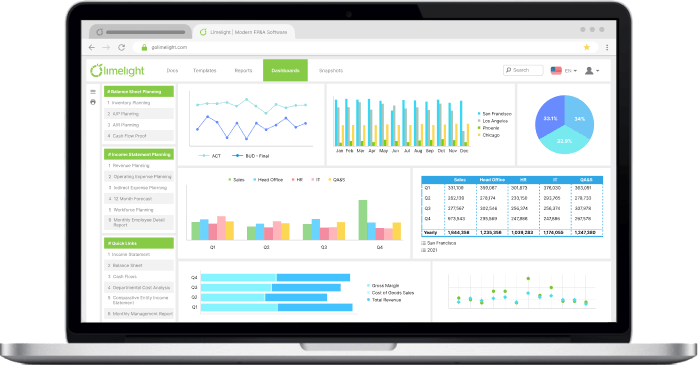Key Takeaways
- Zero-Based Budgeting (ZBB) requires every expense to be justified from scratch, promoting strategic resource allocation and aligning spending with current business goals.
- ZBB is beneficial during economic uncertainty or strategic shifts, allowing organizations to scrutinize expenses and align budgets with new priorities.
- Zero-Based Budgeting is time-consuming and complex for large organizations, requiring detailed analysis and potentially meeting resistance from departments.
- Limelight's FP&A software streamlines Zero-Based Budgeting processes by automating routine tasks, ensuring accurate cost tracking, and aligning budgets with business goals.
- Limelight offers features like real-time insights and data visualization, enhancing decision-making and cost optimization for organizations implementing Zero-Based Budgeting.This article explores what is zero-based budgeting, how it works, and the pros and cons of a based budgeting strategy.
In every budgeting cycle, companies must decide which operational costs to keep or cut. Zero-based budgeting (ZBB) is a budgeting technique that starts from zero, requiring every expense to be justified rather than relying on past budgets. This method helps organizations optimize resources, cut unnecessary costs, and align spending with crucial business goals. ZBB promotes transparency and accountability, ensuring funds support strategic priorities and drive performance.
What is Zero-Based Budgeting?
Zero-based budgeting is a financial planning method that requires each department to start its budget from scratch, ensuring that every expense is fully justified, regardless of past spending. This approach promotes a more strategic allocation of resources, aligning spending with current business goals, unlike traditional budgeting which relies on previous budgets.
An expense is typically either reduced, reallocated, or entirely removed if it isn’t fully justified. The goal is to ensure that only necessary and strategic expenses are included in the budget, optimizing resources to meet the company’s evolving priorities.
Developed in the 1970s by accounting manager Peter Pyhrr, zero-based budgeting was created to better align budgets with corporate goals.
But how is zero-based budgeting beneficial?
Instead of letting historical spending patterns guide future allocations, this budgeting approach allocates funding based on current efficiency and necessity, prioritizing only essential, high-value areas. Industries like procurement and manufacturing quickly adopted zero-based budgeting. In these sectors, where resource optimization is crucial, organizations can channel funds into activities that deliver the most value.
How Zero-Based Budgeting Works?
Companies that implement zero-based budgeting carefully follow a step-by-step process to achieve the most desirable results. Here’s how it typically works:
The budget cycle begins with a comprehensive review of all expenditures at the start of each budgeting period, ensuring every line item is justified to enhance fiscal responsibility and promote cost-effectiveness.
Step 1: Identify Business Goals
Clearly defining an organization's strategic priorities is essential in zero-based budgeting. By aligning the budget with these goals, companies ensure financial resources are directed to the most significant impact areas. This focus ensures that every dollar spent contributes directly to achieving the company's mission, enhancing overall effectiveness, and helping the organization maintain its competitive edge.
Step 2: Analyze Existing Expenses
Before justifying new expenses, reviewing current spending, including operating expenses, to identify redundant or unnecessary costs thoroughly is crucial. This analysis helps streamline budgeting by cutting out wasteful expenses, allowing resources to be reallocated to more impactful areas. A detailed audit ensures that each cost is valid and relevant, making the budgeting process leaner and more efficient, which is key for optimizing financial performance.
Step 3: Justify All Costs for Effective Cost Management
Zero-based budgeting requires all expenses to be justified from scratch, unlike traditional methods that rely on historical allocations. Every department must demonstrate the necessity of each expenditure, whether for operational needs, growth, innovation, or capital expenditures. This approach prevents automatic spending and ensures that all costs contribute meaningfully to the company’s objectives, eliminating the possibility of unnecessary or outdated expenses remaining in the budget.
Step 4: Engage Stakeholders
Involving key personnel from various departments in budgeting helps ensure that the final budget reflects top-level goals and on-the-ground realities. Stakeholder engagement fosters collaboration, providing valuable insights into each department's needs and constraints. This ensures alignment between financial goals and operational requirements, which is critical for maintaining a realistic, well-supported budget that can be effectively implemented across the organization.
Step 5: Integrate Expenditure Thresholds
To prevent overspending and ensure fiscal discipline, it's crucial to establish clear expenditure thresholds for each department. Setting these limits encourages departments to prioritize spending and make decisions based on necessity rather than assuming that more funds will always be available. These thresholds also foster accountability, ensuring each department manages its budget responsibly and within set financial parameters.
Step 6: Consider Changes in Management
Organizational changes, such as new leadership or departmental restructuring, can significantly impact budget allocations and priorities. Zero-based budgeting must account for these shifts to ensure financial resources align with the company's updated vision and structure. By incorporating changes in management into the budgeting process, companies ensure that the budget remains relevant and adaptable, supporting new goals and addressing evolving challenges.
When Should You Use Zero-Based Budgeting?
While ZBB offers many benefits, it may not suit all budgeting needs. Ideal scenarios for ZBB include:
-
Economic Uncertainty: When financial resources are tight, zero-based budgeting allows organizations to scrutinize each expense, ensuring optimal allocation.
-
Strategic Shifts: During strategic change, such as mergers or acquisitions, ZBB can ensure the new budget aligns with the latest priorities.
-
Cost Optimization Goals: If an organization’s objective is to cut costs or streamline expenses, ZBB provides a systematic approach to resource allocation.
By focusing on strategic execution, zero-based budgeting aligns resources with strategic objectives, enhancing operational effectiveness.
.png?width=992&height=227&name=Frame%2030%20(1).png)
Traditional vs. Zero-Based Budgeting
However, traditional budgeting may be more efficient for stable environments with predictable spending needs. Limelight's FP&A solutions can help organizations determine whether ZBB is the right approach or whether a traditional model may work better.
When evaluating budgeting methods, it's important to understand the key differences between Traditional Budgeting and Zero-Based Budgeting (ZBB) and how each method applies to different organizational needs and environments.
Traditional Budgeting
Traditional budgeting builds on the previous year's budget, making incremental adjustments for inflation, revenue changes, or strategic goals.
While this approach is efficient for stable environments with predictable expenses, it can perpetuate inefficiencies as it doesn't require a fresh review of each expense. Resources are allocated based on past spending, which may include outdated or unnecessary costs.
Zero-Based Budgeting (ZBB)
ZBB starts from scratch, requiring each department to justify every expense for the new cycle. Every budget item is reviewed and approved based on its current value to the organization.
This method helps eliminate waste and ensures resources are aligned with the company's most pressing priorities, making it a more strategic and efficient approach.
Pros of Zero-Based Budgeting
There are several benefits of zero-based budgeting, that make it an appealing choice for organizations aiming to enhance their financial management:
-
Cost Efficiency: By requiring justification for each expense, ZBB helps eliminate unnecessary costs and ensures resources are allocated to areas that align with strategic priorities.
-
Transparency: This approach provides clear visibility into spending by analyzing every function within an organization, facilitating informed decision-making.
-
Improved Accountability: Since each department must justify its budget from scratch, ZBB fosters a culture of responsibility and ownership over financial decisions.
-
Flexibility: ZBB allows organizations to adapt their budgets to changing business needs or external factors, ensuring that resources are directed toward current priorities.
-
Optimized Resource Allocation: By focusing on current needs rather than historical spending patterns, ZBB directs funds to high-impact areas, enhancing overall organizational effectiveness.
-
Cost Management: Effective cost management within the framework of ZBB helps businesses identify savings, reallocate resources strategically, and drive sustainable growth despite economic challenges.
For a detailed exploration of these benefits, check out Limelight’s ebook on financial planning, which dives into how companies maximize the advantages of zero-based budgeting. For now, let’s figure out what is a drawback of zero based budgeting:
Cons of Zero-Based Budgeting
While zero-based budgeting is beneficial in many ways, it also presents challenges that organizations must be aware of. Here are some of the most common drawbacks of this approach.
-
Time-Consuming: ZBB requires a detailed analysis of each budget item, making the process more labor-intensive than traditional budgeting.
-
Complexity: This budgeting method can become particularly complex for large organizations with multiple departments, where managing ZBB’s comprehensive approach can be challenging.
-
Resistance to Change: Switching from a traditional budget to ZBB may meet resistance, as departments are now required to justify each expense from the ground up.
-
Potential for Short-Term Focus: ZBB’s emphasis on immediate cost savings might sometimes prioritize short-term gains at the expense of longer-term strategic investments.
-
Variable Expenses: Unpredictable costs that don't fit neatly into a budget can lead to financial shortfalls. Failing to account for these irregular expenses can be challenging, and creating a dedicated savings fund is often suggested to manage these costs effectively.
For organizations aiming to ease these disadvantages of zero-based budgeting, automation tools with planning and forecasting features can help streamline the process, making it more manageable for larger teams.
Zero-Based Budgeting Examples in Action
Zero-based budgeting has become a powerful tool for organizations across industries, helping them navigate financial challenges, optimize resources, and prioritize essential activities. Here are some notable zero based budgeting examples that have been applied effectively: Zero based budgets differ from traditional budgeting methods by requiring justification for all expenses from a zero base each year, rather than simply applying incremental increases from previous budgets.
Corporate Example of zero-based budgeting:
-
Guess: Guess implemented Zero-Based Budgeting (ZBB) during the global pandemic to reduce operational expenditures. By reevaluating each line item in its budget, Guess could trim quarterly operating costs by $60 million in just a few weeks during the fiscal first quarter ending May 2, 2020. This strategic approach helped the company navigate the pandemic’s challenges, focusing resources on its most critical areas and optimizing labor costs based on revised demand forecasts. Companies like Guess allocate funds to different expense categories, allowing for flexibility in financial planning and management.
-
Kraft Heinz: Kraft Heinz adopted Zero-Based Budgeting (ZBB) to streamline operations and minimize costs, enabling the company to focus on growth initiatives and improve overall operational efficiency. This approach allowed Kraft Heinz to redirect resources toward more profitable areas. In 2015, following the merger of Kraft and Heinz, the company implemented ZBB to achieve significant cost savings. By 2016, Kraft Heinz reported approximately $1.5 billion in annual cost savings, primarily through ZBB and other efficiency measures.
Government/Nonprofit Examples:
-
City of Houston, Texas: In Fiscal Year 2021, Houston adopted ZBB across all city departments. This approach required each department to justify every expense from a zero base, aiming to eliminate automatic budget increases and focus on essential services.
-
Nonprofit Organizations: Many nonprofits have embraced ZBB to justify every dollar. By adopting ZBB, these organizations can align their spending with their mission, maximize funding efficiency, and ensure that resources are dedicated to impactful projects.
Real-World Case Studies:
-
Anheuser-Busch InBev (AB InBev): A leading global brewer, has effectively utilized zero-based budgeting (ZBB) to enhance financial performance. By implementing ZBB, AB InBev meticulously justified all expenses from a zero base, leading to significant cost reductions. This approach contributed to improved profit margins and operational efficiency, demonstrating ZBB's effectiveness in large-scale operations.
-
Walgreens: Walgreens applied ZBB to examine expenditures closely, uncovering areas for potential savings, such as closing unprofitable stores and consolidating warehouses. This approach has helped Walgreens optimize its operations and reduce unnecessary costs.
How FP&A Software Helps Streamline Zero-Based Budgeting Processes?
FP&A software simplifies zero-based budgeting (ZBB) by centralizing financial data, streamlining expense tracking, and providing real-time analytics. This technology helps businesses assess and justify expenses accurately, ensuring alignment with current needs and strategic goals. It enhances decision-making, reduces errors, and increases efficiency, making the ZBB process smoother and more effective. Understanding and allocating every dollar of one's monthly income is crucial in this process.
Implementing ZBB without FP&A software is time-consuming and prone to errors. Manual data collection, analysis, and justification of each expense can delay the budgeting cycle and increase the risk of misallocations. Companies may struggle with inefficient processes and inaccurate financial oversight without automation and real-time tracking.
Limelight helps businesses with financial planning and analysis , monitoring expenses, and zero-based budgeting consulting. It simplifies the ZBB process with features like:
-
Expense Tracking & Analysis: Track and analyze spending in real time.
-
Automated Financial Planning: Streamline data collection and reporting.
-
Customizable Budgeting Tools: Tailor your budgeting approach to meet goals.
-
Collaboration & Transparency: Ensure cross-departmental alignment and transparency.
Before getting into zero-based budgeting advantages and disadvantages, take a product tour or request a demo to explore how Limelight can support your organization’s ZBB process.
.png?width=992&height=227&name=Frame%2030%20(2).png)
Limelight's Role in Zero-Based Budgeting
Limelight’s Financial Planning and Analysis (FP&A) software enhances Zero-Based Budgeting (ZBB) by making ZBB more accessible and efficient for finance teams. Limelight isn’t just another finance-focused software; it is a versatile solution offering an advanced budgeting tool suite for top-level organizations looking to achieve more stringent but effective approaches to their budgeting processes.
This unique cloud-based software provides solid ERP systems to forecast, plan, and customize. ZBB aims to allocate every dollar of income to expenses, savings, and debt payments, ensuring that income minus expenditures equals zero by the end of the month.
This is what our customers say!
For companies looking to start over budgeting processes and identify outgrown needs for a new reporting period, Limelight can help shake things up while saving your team valuable time and resources in the following ways.
See Limelight in action:

Automating and Streamlining ZBB Processes
Limelight reduces the time and effort associated with ZBB by automating routine tasks. Its no-code platform allows finance teams to easily transition from manual processes, enabling a focus on strategic decisions rather than time-consuming data entry.
Ensuring Accurate Cost Tracking and Goal Alignment
Limelight helps maintain accurate cost tracking by centralizing planning data and ensuring that budgeting aligns with business goals. The platform's flexibility allows users to create various budgeting models, including zero-based approaches tailored to specific organizational needs.
Key Limelight Features Supporting ZBB
-
Data Visualization: Limelight offers interactive dashboards and reporting tools that make complex data more accessible for understanding and using for decision-making.
-
Cost Optimization: The platform supports scenario modeling and agile resource allocation, enabling organizations to explore different budgetary outcomes and optimize costs effectively.
-
Real-Time Insights: Real-time data integration keeps all stakeholders informed with the latest financial information, fostering transparency and timely responses to financial changes.
FAQs
1. What's the difference between zero-based budgeting and traditional budgeting?
Traditional budgeting modifies the previous budget, often resulting in incremental changes, while ZBB starts from zero each period and requires justification for all expenses.
2. Can zero-based budgeting work for businesses?
Absolutely. In a B2B context, zero-based budgeting ensures every dollar is purposefully allocated to key functions or initiatives, eliminating waste and aligning spending with strategic priorities.
3. What are some challenges companies face with zero-based budgeting?
Common drawbacks of zero-based budgeting include the time required for detailed analysis, potential resistance from departments, and the risk of focusing too heavily on short-term cost-saving rather than long-term goals. However, sound financial planning tools like Limelight reduce these setbacks and enhance efficiency in financial planning.




.png?width=992&height=227&name=Frame%2030%20(1).png)
.png?width=992&height=227&name=Frame%2030%20(2).png)



.png?width=381&height=235&name=linkedinreal%20(27).png)
